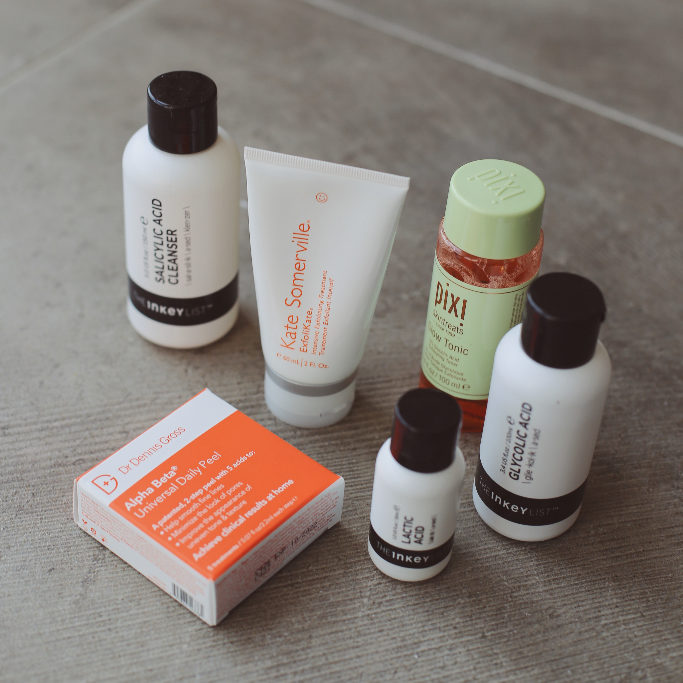Let’s talk about skincare acids.
I talk a lot about using skincare acids in my routine, so in this post I’m going to cover the most popular acids for exfoliation, and how to build them in to your skincare routine.
Why do we exfoliate?
Exfoliation is one of the most important steps in any basic skincare routine.
It gets rid of dead skin cells and helps to unblock pores which in turn reduces breakouts.
It can help reduce fine the appearance of fine lines and wrinkles, and it allows your other products to work more effectively as they’re penetrating a brand-new layer of skin. And by removing the dead skin, you’re left with fresher, glowier skin. Win.
To try and keep this post short and sweet I’m going to focus on the acids that are the most popular, and the ones we’re most familiar with.
Salicylic Acid, Glycolic Acid, and Lactic Acid
These acids fall into two different categories; Alpha Hydroxy Acids, or AHAs, and Beta Hydroxy Acids, or BHAs.
Alpha Hydroxy Acids (AHAs) work on the surface of the skin. They’re fantastic for anti-aging, for getting rid of dead skin cells, and for giving you that glow.
Glycolic Acid and Lactic Acid are AHAs. Glycolic Acid is generally considered the holy grail for exfoliation. It removes dead skin cells, evens skin tone, resurfaces and smooths, it’s anti-aging, and because of its strength it generally needs to be introduced slower.
Lactic Acid also resurfaces the skin, improves skin tone and texture, reduces the appearance of fine lines and wrinkles, targets pigmentation, however, it’s quite a bit gentler than Glycolic Acid, and more moisturizing
Beta Hydroxy Acids (BHAs) work on the deeper layers of the skin. They’re fantastic for breakouts, for acne prone, or congested skin.
Salicylic Acid is a BHA. It gets deeper into the skin, unblocks pores, reduces breakouts and the appearance of blackheads, resurfaces the skin, and is great for oily, or acne-prone skin.
AHAs and BHAs can be used daily, and they can also be used together – as they target different layers of the skin. There’s lots of great products on the market now that have both AHAs and BHAs.
If you’re not using acids at all in your skincare routine, and you would like to introduce them – make sure to do it slowly. Start using them once a week, and build up from there, taking note of how your skin reacts.
Skincare acids come in many forms; cleansers, toners, masks, exfoliating pads, etc.

Polyhydroxy Acid (PHA)
Considered a very gentle cousin of Alpha Hydroxy Acids, PHAs are arguably the gentlest of all chemical exfoliants. PHAs have a much larger molecule and so they don’t penetrate the skin as deeply as AHAs and BHAs. This means they’re significantly less irritating and a really great option for sensitive skin. When used regularly they will help you achieve smoother, brighter, glowier skin.
I’ve linked some of my favourite from each type of acid below. Keep scrolling to find out more about them.
AHAs – the below products are great for resurfacing the skin, getting rid of dead skin cells, reducing the appearance of fine lines and wrinkles, and so on.
Pixi Glow Tonic is a great one to start with, if you’re not using any acids right now.
It has 5% Glycolic Acid and is gentle enough for daily use, when built up over time.
The Inkey List Glycolic Acid is a favourite of mine. I’ve raved about it many times. It has 10% Glycolic Acid so it’s twice the strength of Pixi Glow Tonic. I use Glycolic Acid two to three times a week. I use it at night, after cleansing.
The Inkey List Lactic Acid is also an AHA, so it’s from the same family as Glycolic Acid. But it’s a lot gentler than Glycolic Acid. Lactic Acid is more moisturizing and less irritating. This product also has 1% Hyaluronic Acid for extra hydration. If you have very sensitive skin that’s prone to redness or irritation I would opt for Lactic Acid over Glycolic Acid.
BHAs – the below products are great for penetrating deeper layers of the skin, helping to stop breakouts and target congestion.
The Inkey List Salicylic Acid Cleanser. This is great cleanser for oilier skin, or for skin prone to hormonal acne, breakouts, or congestion.
Products that have both AHAs and BHAs – the below products exfoliate, reduce the appearance of fine lines and wrinkles, smooth and brighten the skin, and target breakouts, congestion, etc.
Dr. Dennis Gross Alpha Beta Universal Daily Peel
PHAs
And there we have it.
For more deep-dives into skin issues and ingredients, take a look at the Skincare Guides section of my website.

